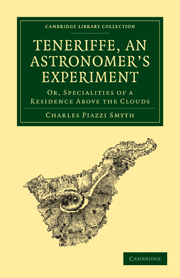Book contents
- Frontmatter
- PREFACE
- Contents
- LIST OF PHOTO-STEREOGRAPHS
- PART I THE VOYAGE AND THE CLIMB
- PART II ON THE CRATER OF ELEVATION
- PART III ON THE CRATER OF ERUPTION
- CHAP. I SCALING THE CENTRAL CONE
- CHAP. II EARLY EXPERIENCES AT ALTA VISTA
- CHAP. III BRINGING UP THE TELESCOPE
- CHAP. IV BATTLE OF THE CLOUDS
- CHAP. V SUMMIT OF THE PEAK
- CHAP. VI AUTUMN IN EXCELSIS
- CHAP. VII THE REITERATED QUESTION
- CHAP. VIII THE ICE CAVERN
- CHAP. IX LAST OF THE MOUNTAIN
- PART IV LOWLANDS OF TENERIFFE
- INDEX
CHAP. VI - AUTUMN IN EXCELSIS
Published online by Cambridge University Press: 05 July 2011
- Frontmatter
- PREFACE
- Contents
- LIST OF PHOTO-STEREOGRAPHS
- PART I THE VOYAGE AND THE CLIMB
- PART II ON THE CRATER OF ELEVATION
- PART III ON THE CRATER OF ERUPTION
- CHAP. I SCALING THE CENTRAL CONE
- CHAP. II EARLY EXPERIENCES AT ALTA VISTA
- CHAP. III BRINGING UP THE TELESCOPE
- CHAP. IV BATTLE OF THE CLOUDS
- CHAP. V SUMMIT OF THE PEAK
- CHAP. VI AUTUMN IN EXCELSIS
- CHAP. VII THE REITERATED QUESTION
- CHAP. VIII THE ICE CAVERN
- CHAP. IX LAST OF THE MOUNTAIN
- PART IV LOWLANDS OF TENERIFFE
- INDEX
Summary
After our visit to the caldera of the Peak, with its walls of rock bleached by steam, and by acid vapours permeating them for ages, we could better understand the remarkable internal whiteness of lunar volcanoes, as shown by our telescope at Alta Vista.
Some geologists have, indeed, denied that the features seen by astronomers in the moon are to be considered as volcanoes; but we who duly noted the gentle external slope of some of those circular pits, their cliffy internal descents, their flat floors, and their central peaks—had little doubt in our minds. Occasionally could be traced something much like a collection of stony lava streams; which even the Spanish attendants, when looking by permission into the telescope, would call a Malpays. Generally too would they describe what they saw, with the same terms that they employed, for volcanic features of the mountain whereon we stood.
Could we have found in the moon, that dynamic trace, which was so important in proving relative ages among the red and yellow lavas of Teneriffe, viz., glacier wrinkles in one, and surf-like waves in the other,—all sceptical doubts must vanish. But we failed, and this point is left to a larger telescope, more constantly employed in lunar physics, on this or some higher mountain.
Details of a larger sort, however, were multitudinously brought out by the Pattinson Equatorial; to such an extent, indeed, as to be hopelessly beyond my poor efforts, to record them usefully in the small portion of time, that was available each evening.
- Type
- Chapter
- Information
- Teneriffe, an Astronomer's ExperimentOr, Specialities of a Residence Above the Clouds, pp. 317 - 332Publisher: Cambridge University PressPrint publication year: 2010First published in: 1858



